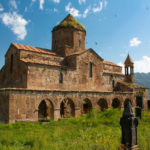The Armenian alphabet is a true masterpiece of its era and knows many secrets. However, there is one in particular that still blows the mind.
As some people know the Armenian alphabet was (re)invented in 405 AD by the Armenian linguist and theologian Mesrop Mashtots with the help of the patriarch Sahak Partev and the Armenian king Vramshapouh. For these achievements Mashtots was made a saint in the Armenian Church. One of Mashtots’s pupils by the name of Koryun wrote the autobiography of Mashtots known as “Varq Mashtotsi” (Life of Mashtots). He describes that when creating the letters he struggled a long time without success, until one day miraculously he received a vision from God who instructed him and aided in this process. The first sentence to be written down in the new Armenian alphabet by Mashtots was:
Ճանաչել զիմաստութիւն եւ զխրատ, իմանալ զբանս հանճարոյ:
To know wisdom and instruction; to perceive the words of understanding. — Book of Proverbs, 1:2.
The Armenian alphabet is not only an enigma when it comes to its creation, it also holds many astonishing hidden features. So much so that one would almost have to conclude that it was indeed either comprised by divine intervention or Mashtots together with Sahak ware linguistic geniuses far ahead of their time. The original alphabet had thirty-six letters, with two being added later on in the 12th century to represent foreign sounds. But for the sake of the argument we are going to stick with the 36 Mashtotsian letters in this post.
Numbers and Dates
The Armenian alphabet was not just a writing system, it was also a numerical system used for math calculations and recording calendar dates.
Not only do all the letters have their own numerical value based on their order in the alphabet, but they also differ in decimals. They are arranged in 4 columns and 9 rows. The first column represents single digits, the second represents tens, the third represent hundreds and the forth represents thousands.
Sacred Geometry
The Armenian alphabet has many geometrical secrets hidden in it of which we shall discuss a few.
For example the fist letter of the Armenian alphabet is A «Ա» and stands for “Astvats” which means God, while the last letter in the alphabet is K «Ք» which stands for “Kristos” meaning Christ.
Now, if we arrange the Armenian alphabet into an equilateral triangle, the three letters at the edges read A, K and S describing the trinity, the Father God (Astvats), Son Christ (Kristos) and the Holy Spirit (Surb Hogin) of the Christian faith.
Similarly, if we to arrange the Armenian letters inside a square of an octagram, reading clockwise, the letters at the edges form the old native Armenian name for the country ՀԱՅՔ “Hayk”. The Armenian name of the homeland of the Armenian people.
Prophetic Alchemy
By now you might think to yourself; “the Armenian alphabet is certainly impressive”. However, we’re not done yet. Remember the mind-blowing secret we promised? Well here it comes.
The numerical order of the Armenian letters appears to correspond with the atomic numbers of chemical elements from the periodic table for the 7 metals known in the antiquity. The metals of antiquity are the seven metals which humans had identified and found use for in prehistoric times: gold, silver, copper, tin, lead, iron, and mercury. These seven are the metals from which the modern world was forged.
Each of the metals was associated with one of the seven then-known celestial bodies, and one of the seven days of the week.
The periodic table is a tabular arrangement of the chemical elements, arranged by atomic number, electron configuration, and recurring chemical properties, whose structure shows periodic trends.
The atomic number or proton number of a chemical element is the number of protons found in the nucleus of an atom. For example gold (latin: Aurum), Au in the table, has 79 protons in the nucleus of its atoms.
As discussed earlier, ever letter in the Armenian alphabet has a number attached to it.
Now, here is the interesting part. Let’s take the word “Gold” Voski in old Armenian. It is comprised of 4 letters “ՈՍԿԻ”. In alphabetical order Ո is the 24th letter, Ս is 29th, Կ is 15th and finally, Ի is 11th. If we add these numbers together 24+29+15+11=79 we get the number 79. Which is exactly the atomic number for the chemical element Au (Gold) in the periodic table.
And if you thought this was just a coincidence, think again! It applies to all of the 7 metals known in the antiquity.
The astonishing part here is that the periodic table wasn’t actually known in the antiquity. It was only invented in the 19th century. That’s almost 1500 years after the (re)invention of the Armenian alphabet. So, even though the 7 elements ware known at the time Mashtots completed his work, there is no way he could have known the periodic table or the atomic structure of chemical elements. So did he actually receive a divine vision, or is there another less spiritual explanation?
Regardless of how this came about, there is no doubt that the Armenian alphabet is a piece of historic art, arranged by a true visionary polymath way ahead of his time.


.png)






